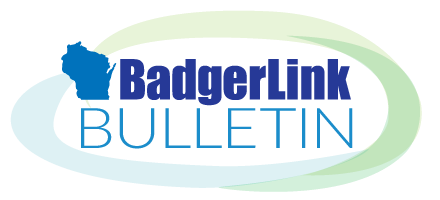As we near the half-way mark of 2021, BadgerLink staff reflected back on 2020, both in the challenges we faced as well as the many opportunities for growth, as we continue to support all learners around the state.
Highlights
This past year, we were reminded first and foremost the importance of being nimble and adapting to the changing needs of our users. We’ve learned technology can improve our lives but doesn’t always come easy, so patience and understanding is paramount to success. And while we know research databases may not have been every library’s top priority during the pandemic, we look forward to continuing to highlight their value in the new normal.
![]() With the swift transition to virtual learning, students and staff were no longer able to rely on seamless access to BadgerLink resources in their libraries and schools. To rectify this, we increased collaboration with school libraries, resulting in almost 150 districts adding customized logins to guarantee equitable access from any location. In addition, as more schools adopted learning management systems, library management platforms, or single sign-on tools, we focused on the guidance needed to integrate resources into these systems, placing access where students already are.
With the swift transition to virtual learning, students and staff were no longer able to rely on seamless access to BadgerLink resources in their libraries and schools. To rectify this, we increased collaboration with school libraries, resulting in almost 150 districts adding customized logins to guarantee equitable access from any location. In addition, as more schools adopted learning management systems, library management platforms, or single sign-on tools, we focused on the guidance needed to integrate resources into these systems, placing access where students already are.
We were able to provide temporary statewide access to additional historic newspapers and enhanced versions of education databases, use our authentication to help some public libraries provide remote access to their Ancestry Library subscriptions, and reach more users with virtual training sessions. We also added permanent resources from EBSCO including Advanced Placement Source, Computers & Applied Sciences Complete, Literary Reference Center Plus, MAS Complete, Poetry & Short Story Reference Center, and Small Engine Repair Reference Center, as well as Book Connections from TeachingBooks.
Resource Usage
Resource usage fluctuated in 2020, with many K12 databases including those from Britannica, EBSCO, and LearningExpress Library, seeing a consistent decrease beginning in April and continuing through the end of the year. This drop coincided with anecdotes from both the BadgerLink Advisory Group members as well as the library community at large. As priorities shifted in schools, traditional research and library instruction decreased.
However, resources supporting readers saw large increases in usage as both library staff and the general public ramped up their use of reader’s advisory tools and other literacy materials. TeachingBooks averaged a 55% increase compared to 2019, and NoveList K-8 saw an enormous increase in searches. We heard from many library staff fielding book requests that these resources became indispensable in sharing recommendations with patrons and students.
![]()
In a year where the news cycle was so prevalent in everyone’s lives, we saw an average increase in both of our newspaper databases that offer access to current, local and national newspapers, even while many news outlets offered unrestricted access to COVID-19 content. In contrast, at a time when so many people were beginning new hobbies like baking and gardening, we saw an average decrease in traditional genealogy databases including HeritageQuest Online and historic newspapers in Newspapers.com Library Edition World Collection.![]()
Changes in education and public libraries, lifestyle, and opportunities for access to resources beyond what was typically offered, played a role in the overall use of BadgerLink in 2020, but these events do not necessarily imply causation. The pandemic’s impact on electronic resource usage won’t truly be understood for years to come.
Throughout all of this, the BadgerLink Advisory Group and library community at large has been a great source for feedback and support. Thank you!

